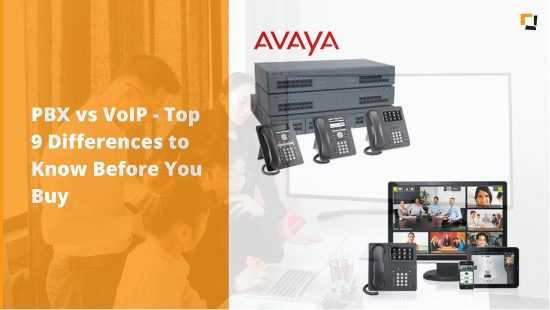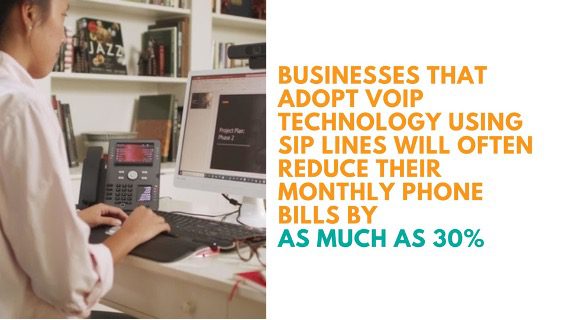Is your business still relying on a traditional PBX system for communication? Are you considering updating your existing PBX with added VoIP technology?
If so, this article is for you!
At Office Interiors, we understand upgrading your phone infrastructure is no easy feat. Even with several contact channels available today, a business phone that is rich in features and easy to manage is still a must-have. In previous years, companies picked a traditional landline phone as there was no other alternative. Now, there are far more options to choose from.
This article will provide a complete breakdown of PBX vs VoIP systems, including costs, maintenance, benefits analysis, etc.
Let’s start with the basics of PBX and VoIP systems.
What is PBX?
PBX, or Private Branch Exchange, is a private telephone infrastructure that uses landline telephones to send/receive calls over the Public Switched Telephone Network (PSTN). It supports various valuable features while allowing general telephone service such as extension dialling, caller queues, call conferencing, etc.
What is VoIP?
VoIP (Voice Over Internet Protocol) is a technology for transmitting voice data.
Through this software, your voice is recorded and transformed into data. The system compresses these files in real time and turns them into data packets. The packets are then sent to your VoIP provider, after which they are converted and connected to the target phone.
How Can I Add VoIP to My Existing PBX?
Most modern PBX systems (like the ones we offer at Office Interiors) are compatible with VoIP technology, and the software can be added to the system through SIP Trunking.
Based on the SIP protocol, SIP trunking is basically a service established virtually over your internet connections and provided by Internet Telephony Service Providers (ITSP), eliminating the physical connection to a phone company.
This enables customers to utilize the features of a VoIP solution but position the infrastructure for a PBX. Users can make and receive phone calls over the Internet while maintaining analog phones throughout the office.
PBX vs VoIP – Top 9 Differences
As we mentioned earlier, there are pros and cons to both sticking to your traditional PBX system and switching to VoIP technology. Below, we highlight nine vital differences to help you choose the right system for your communication needs.
1. Upfront Investment
Installing a PBX system on-site involves many upfront costs and significant investment. You’ll need an uninterruptible power supply, expensive routers, software, and other hardware. The average PBX system is $4500. Although, the price can fluctuate based on the type and configuration.
In contrast, IP phones are the primary hardware you need for VoIP. Further cost savings can be achieved by ditching the phone set and using USB headsets to call through your computer.
2. Running Costs
VoIP providers typically follow a subscription model. Avaya offers several subscription models, including one allowing you to pay as little as $20 per month per user. Even the basic plans provide PBX features like call routing and forwarding.
The running costs of on-site PBX depend on your setup. They could include software licenses, maintenance and service fees, updates, and phone bills. PBX business landline costs can be up to 30% more expensive than VoIP running on SIP lines.
3. Call Quality
VoIP has come a long way since it first struggled to make IP phones a reality in 1995. Now, most VoIP providers deliver HD voice calls using the same audio codec as PSTN (Public Switched Telephone Network). However, insufficient bandwidth or network configuration errors can impact the call quality.
With PBX, the call quality depends mainly on the hardware, which includes the routers and phone models. If the system is appropriately set up and the phone models are high-quality, so will the calls.
4. Scalability
VoIP technology has made it possible to scale your call center’s technology rapidly. You can order more phones to increase the number of users on your calling plan. You may have to upgrade your broadband internet plan, but another upside is that multiple branches or offices can use the same VoIP plan.
With PBX, it’s more complex. You have to add extra phone lines and install new hardware. Additionally, if you’re expanding to a new address, you must install a completely new PBX system for that location.
5. Team Mobility
VoIP makes it possible to handle calls from your computer or mobile phone. Avaya Cloud Office offers native apps for iPhones, Android, and computers. Team members can link personal mobile devices to the system, which means they can access calls, texts, and other information from anywhere with an internet connection. They can make or receive calls, voicemails and text messages not only from their desk phone but also from their smartphone or PC. VoIP also acts as an excellent hiring asset, as 92% of millennials prioritize flexibility when job hunting.
On-premise PBX systems rely on an internal data network to connect their phones, so team members cannot make or receive calls outside the office.
6. Security
VoIP security varies from one service provider to the next. With Avaya Cloud Office, all data is encrypted in transit and at rest, using applicable industry-leading encryption, standards, and protocols.
Avaya Cloud Office addresses vulnerabilities in the VoIP data plane by safeguarding communications with advanced features such as end-to-end encryption, two-factor authentication, password protection, 24/7 network monitoring and much more.
On the other hand, a traditional PBX relies on the copper wiring of the PSTN, which is significantly less prone to security issues than VoIP. A PBX eliminates cyber security threats by taking the internet out of the equation entirely. However, it is important to remember that if you run your PBX system on SIP lines, a breach of your internal network could also mean a breach in your phones.
7. Outages
PBX systems, with internal servers and gateways, are reliant on electricity.
VoIP, similarly, connects with the PSTN through the internet, and modems need the power to function. However, with a VoIP system, you can log in and send/receive calls from any other location with power and an internet connection. For instance, you can take calls from home if your office faces a power outage.
So, PBX and VoIP tie in here, as both will go offline with an outage. However, with VoIP, you have the option to effortlessly move your work to another location without putting a halt to your business operations.
8. IT Team Involvement
Installing a PBX is time-consuming and requires your IT team’s help. Since you own and manage the system, updating and monitoring it is your responsibility. If any features stop working, your staff must troubleshoot and fix the issues.
Whereas with VoIP, the provider handles all the sophisticated hardware and software.
9. Best Use Cases
PBX systems might be better for companies with no plans for future expansion and limited technology budgets.
Enterprises and distributed companies will benefit greatly from VoIP as using the same plan across all offices will reduce costs and improve company-wide communication. The centralization of data will also provide managers and analysts with a better understanding of performance in real time.
Ready to Take Your Business Communications to the Next Level?
As you can see from this article, when deciding between sticking to your existing PBX or adopting VoIP, the latter is the better overall choice.
Not only does adding VoIP offers significant cost savings over premise-based PBX, but it also comes with more features, high levels of mobility and scalability, robust security standards, and more.
If you’re excited about reaping the benefits of VoIP technology on your PBX system and gaining a reliable new partner in communications, reach out to us! We’d be happy to help you with customized solutions that are best for your business.
Ahona Saha
Marketing Assistant
Office Interiors






